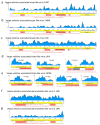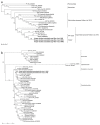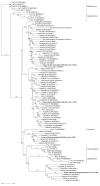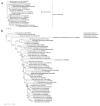Viruses in the Invasive Hornet Vespa velutina
- PMID: 31717432
- PMCID: PMC6893812
- DOI: 10.3390/v11111041
Viruses in the Invasive Hornet Vespa velutina
Abstract
The Asian yellow-legged hornet Vespa velutina nigrithorax, a major predator of honeybees, is spreading in Europe in part due to a lack of efficient control methods. In this study, as a first step to identify biological control agents, we characterized viral RNA sequences present in asymptomatic or symptomatic hornets. Among 19 detected viruses, the honey bee virus Deformed wing virus-B was predominant in all the samples, particularly in muscles from the symptomatic hornet, suggesting a putative cause of the deformed wing symptom. Interestingly, two new viruses closely related to Acyrthosiphon pisumvirus and Himetobi Pvirus and viruses typically associated with honey bees, Acute bee paralysis virus and Black queen cell virus, were detected in the brain and muscles, and may correspond to the circulation and possible replication forms of these viruses in the hornet. Aphid lethal paralysis virus, Bee Macula-like virus, and Moku virus, which are known to infect honey bees, were also identified in the gut virus metagenome of hornets. Therefore, our study underlined the urgent need to study the host range of these newly discovered viruses in hornets to determine whether they represent a new threat for honey bees or a hope for the biocontrol of V. velutina.
Keywords: ABPV; ALPV; BQCV; BeeMLV; DWV; KBV; Vespidae; honey bee viruses; invasive species; new viruses.
Conflict of interest statement
The authors declare no conflict of interest.
Figures








References
-
- Villemant C., Barbet-Massin M., Perrard A., Muller F., Gargominy O., Jiguet F., Rome Q. Predicting the invasion risk by the alien bee-hawking yellow-legged hornet Vespa velutina nigrithorax across Europe and other continents with niche models. Biol. Conserv. 2011;144:2142–2150. doi: 10.1016/j.biocon.2011.04.009. - DOI
-
- Haxaire J., Bouguet J.-P., Jean-Philippe T. Vespa velutina Lepeletier, 1836, une redoutable nouveauté pour la faune de France (Hym., Vespidae) Bull. Soc. Entomol. Fr. 2006;111:194.
-
- Villemant C., Haxaire J., Streito J.-C. La découverte du frelon asiatique Vespa velutina, en France. Insectes. 2006;143:3–7.
-
- Arca M., Capdevielle-Dulac C., Villemant C., Mougel F., Arnold G., Silvain J.F. Development of microsatellite markers for the yellow-legged Asian hornet, Vespa velutina, a major threat for European bees. Conserv. Genet. Resour. 2012;4:283–286. doi: 10.1007/s12686-011-9525-1. - DOI
-
- Arca M., Mougel F., Guillemaud T., Dupas S., Rome Q., Perrard A., Muller F., Fossoud A., Capdevielle-Dulac C., Torres-Leguizamon M., et al. Reconstructing the invasion and the demographic history of the yellow-legged hornet, Vespa velutina, in Europe. Biol. Invasions. 2015;17:2357–2371. doi: 10.1007/s10530-015-0880-9. - DOI
Publication types
MeSH terms
Substances
Supplementary concepts
LinkOut - more resources
Full Text Sources

